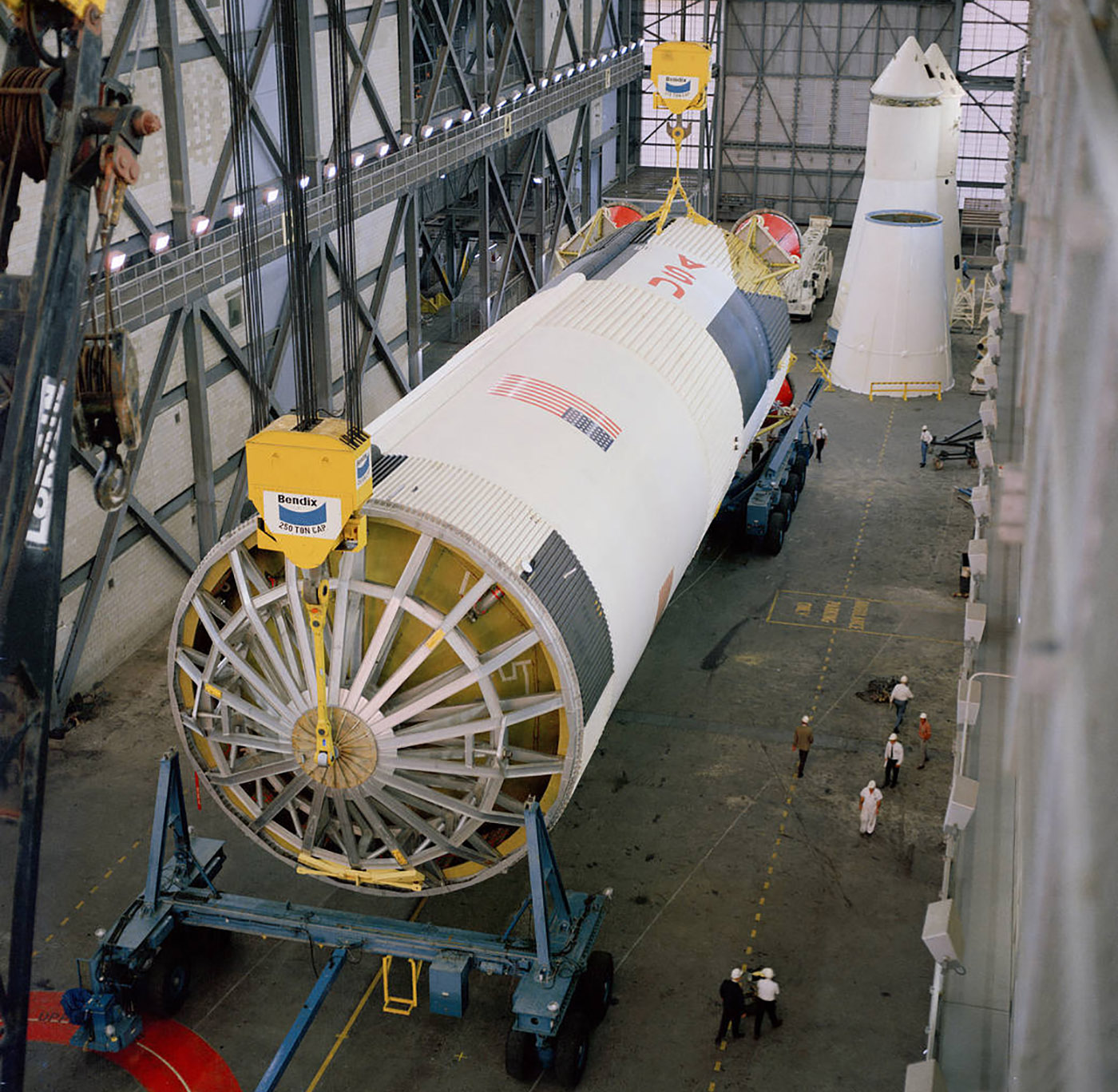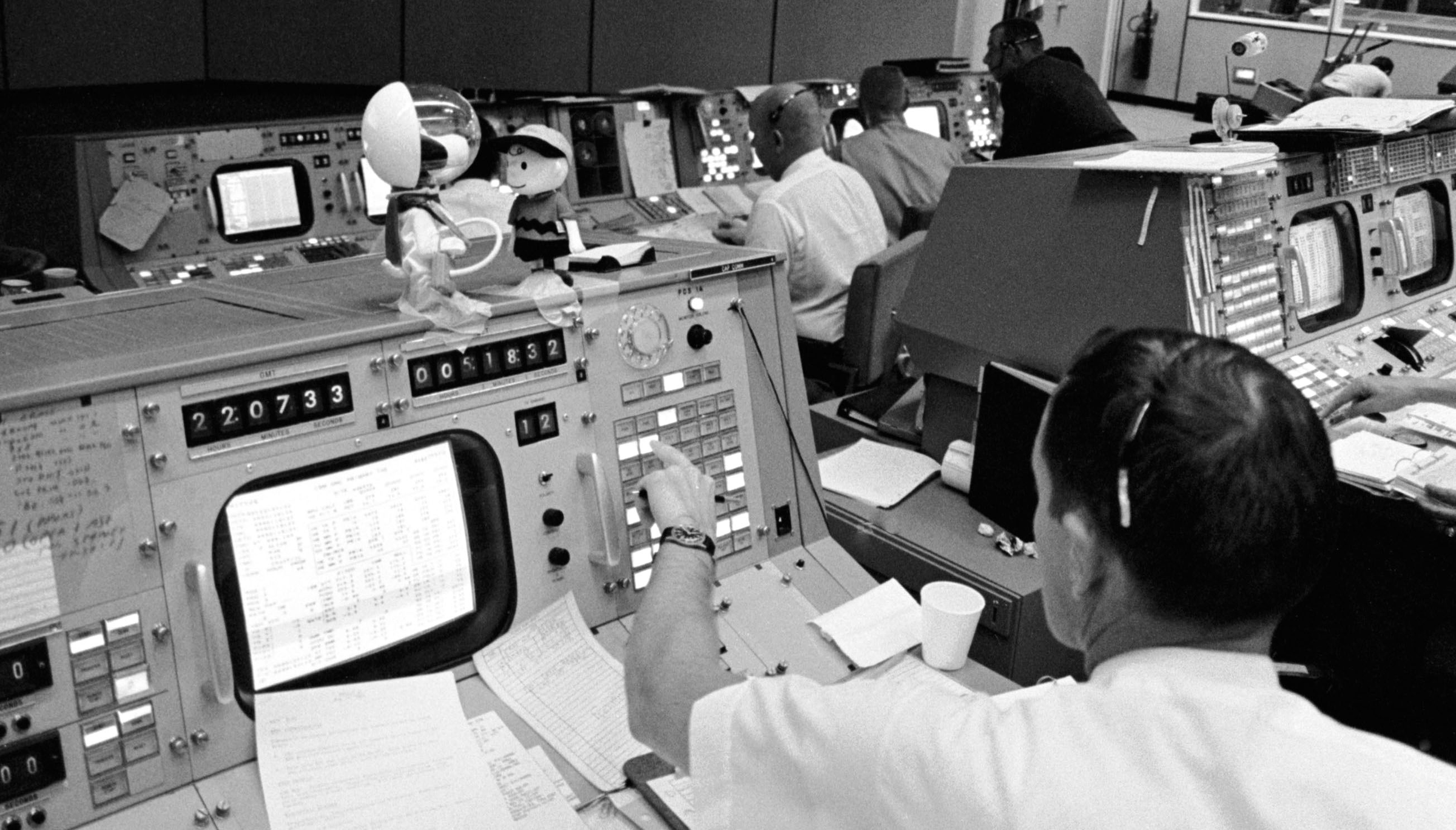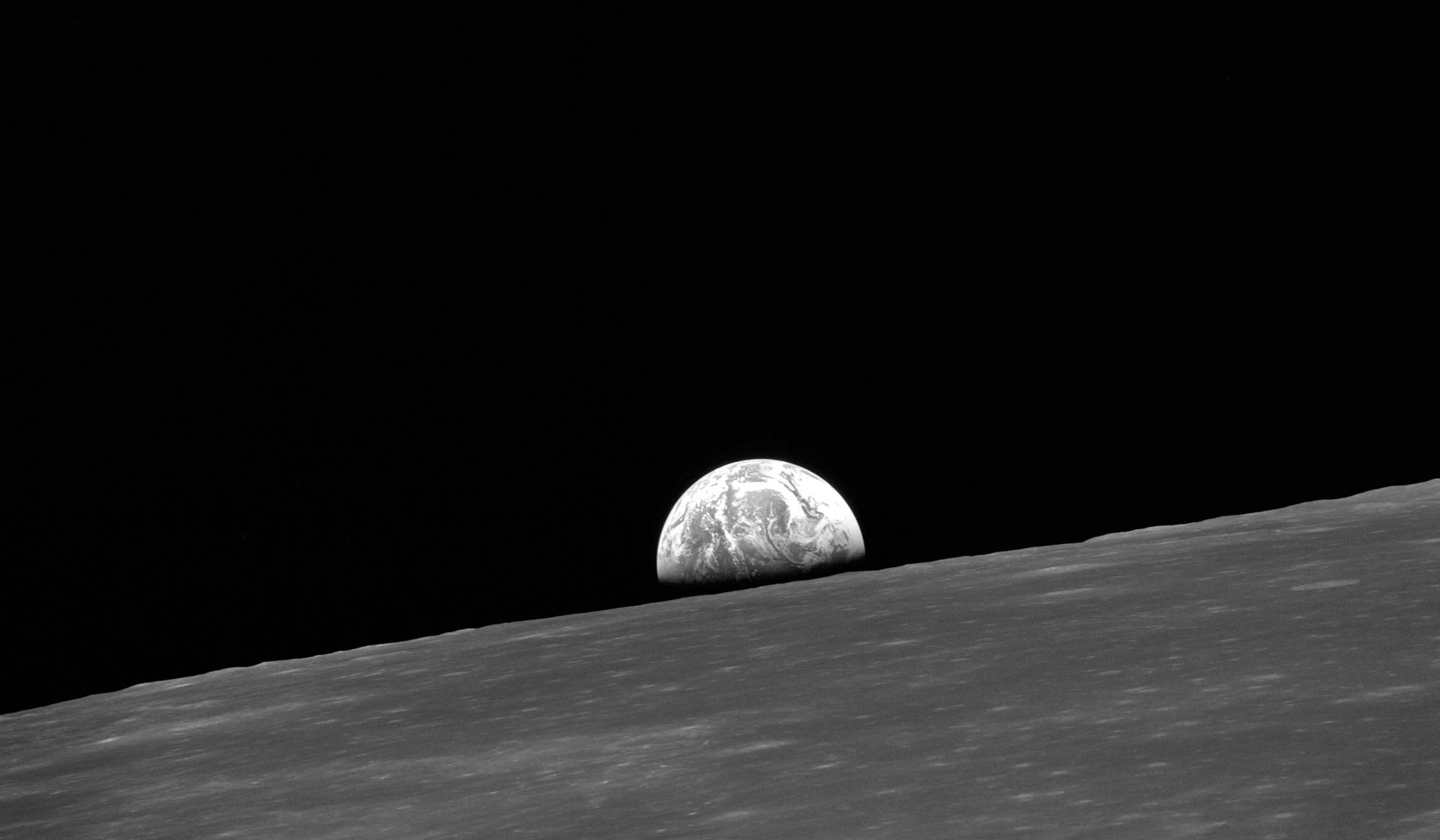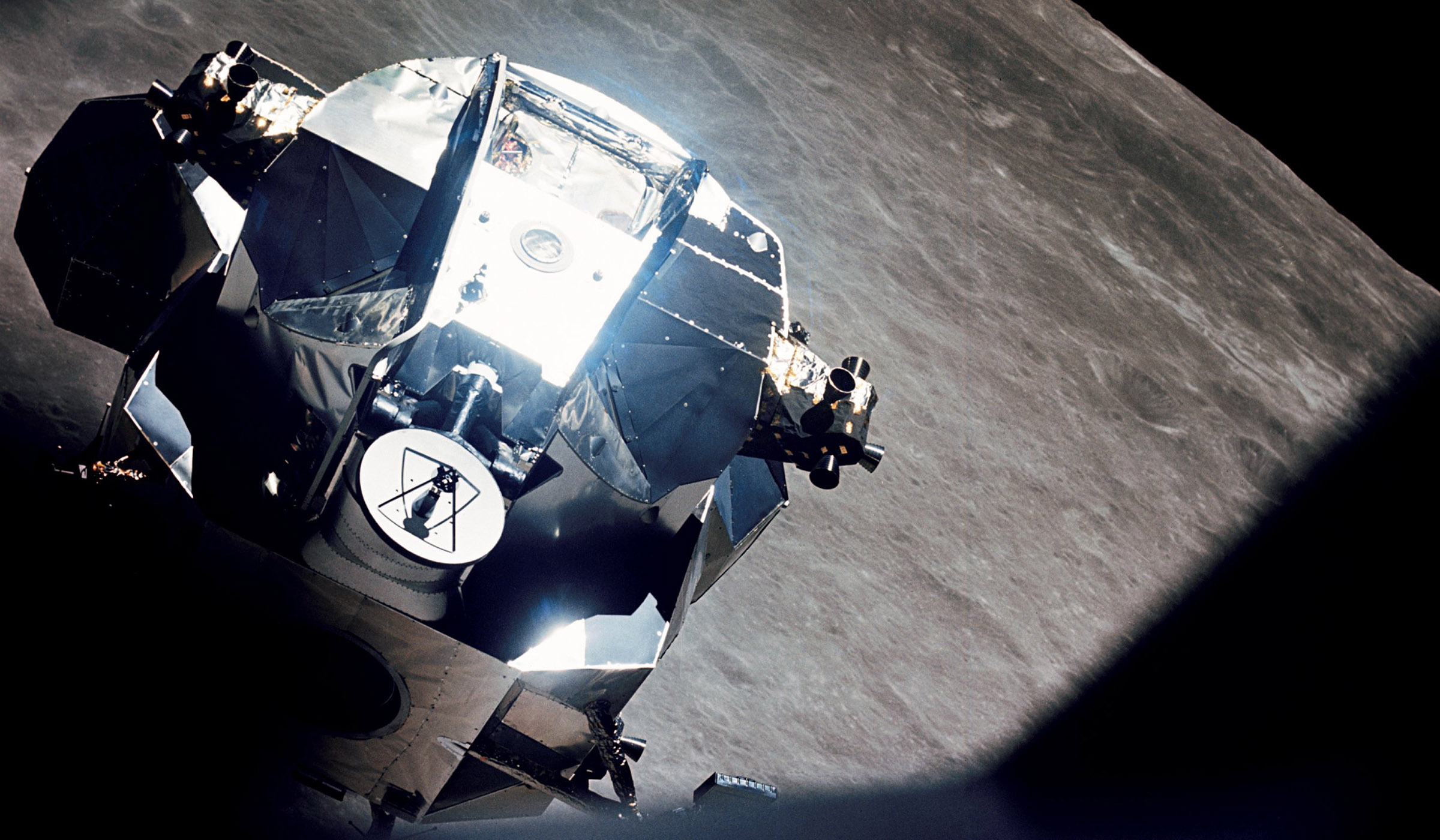
Arrival, off-loading from the barge, and transfer to the Vehicle Assembly Building VAB, of the Saturn 505 S-IC stage for the Apollo 10 mission. Image Credit: NASA
A multi-part series on the history of NASA's Apollo missions.
Apollo 10, which began on May 18,1969, was the dress rehearsal for the lunar landing. Astronauts Thomas P. Stafford and Eugene A. “Gene” Cernan, in their Lunar Module (LM), named “Snoopy,” flew within ten miles of the lunar surface while John W. Young orbited overhead in the Command Module (CM), which they named “Charlie Brown.”

Arrival, off-loading from the barge, and transfer to the Vehicle Assembly Building VAB, of the Saturn 505 S-IC stage for the Apollo 10 mission. Image Credit: NASA
They named their spacecraft after the characters in Charles Schulz’s popular cartoon strip “Peanuts.” Apollo 10 had the most experienced crew launched to date. Mission Commander Stafford and Command Module Pilot Young had each made two previous flights; Lunar Module Pilot Cernan had been in space once before.
Kennedy Space Center Launch Complex 39 had two launching pads. Apollo 10 was the first piloted flight to use Pad B. Apollo 10 reached orbit 12 minutes after liftoff. During their second orbit around the Earth, the Saturn’s third stage engine fired for about six and a half minutes to send Apollo 10 on its way to the Moon.
Apollo 10 carried a color television camera and the astronauts made 10 broadcasts while they coasted to the Moon. Their first broadcast showed the docking with the LM and its extraction from the booster rocket. On subsequent transmissions they shared views of the Earth and their spacecraft interior with audiences on the ground.

Snoopy and Charlie Brown sit atop of a console in the Mission Control Center. Image Credit: NASA
On May 21, Apollo 10 swept into orbit around the Moon. During their first orbit, the crew broadcast vivid descriptions of the lunar surface. The first comment came from Stafford, who reported seeing a “couple of real good volcanoes.” This was particularly interesting to geologists and astronomers because there was an ongoing debate over whether the Moon had seen volcanic activity or not. Young described the volcanoes as “all white on the outside but definitely black inside.”
Much of the Moon’s surface appeared gray-white but under some lighting conditions it had a brown tint. There were areas with huge boulders. Televised views of the Earth from lunar orbit showed its apparent size to be between that of a golf and tennis ball.
The next day, the crew prepared for the high spot of the mission: the low approach across the Moon. When they opened the hatch leading to the LM, they found an unwelcome surprise. Mylar insulation in the docking tunnel had come loose and apparently collected on the docking ring. This let Snoopy slip 3.5 degrees out of line with Charlie Brown. The misalignment may have also been caused by having the Service Module roll thrusters left on after docking.
The crew feared the misalignment might shear off some of the docking latch pins when they separated the two spacecraft and prevent redocking. Mission Control advised them they would be okay so long as the misalignment did not exceed 6 degrees. As the crew acknowledged this instruction, they passed behind the Moon. On Earth, ground controllers could only wait to find out if they undocked or not.
Thirty six minutes later, Snoopy and Charlie Brown, flying independent of each other, emerged from behind the Moon. Stafford and Cernan were busy preparing for their descent. Later that afternoon, they fired Snoopy’s descent engine. About an hour later, Cernan reported “we is down among them!” as he and Stafford swooped across the Sea of Tranquility at an altitude of 47,400 feet (7.8 nautical miles). Both astronauts marveled at the craters and boulders below them. They tested the landing radar and practiced every maneuver needed to land except one -- the final burn of the descent stage engine that would take them to the surface.

Earthrise from lunar orbit. Image Credit: NASA
About 17 minutes after their closest approach to the Moon, Stafford and Cernan fired the descent engine to place Snoopy in an elliptical orbit with a low point, or perilune, of 12.1 nautical miles and a high point, or apolune, of 190.1 nautical miles. This maneuver put them in the correct position relative to Charlie Brown to simulate a normal lunar liftoff trajectory.
In the years since the flight, a number of people have speculated what would have happened had the crew decided to perform that final engine burn and landed. Such a stunt would have been a one-way trip. While Snoopy carried 18,218 pounds of propellants in the descent stage, enough for a landing, the ascent stage only held 2,631 pounds of propellants, about half that carried by subsequent Lunar Modules. While this was enough for the planned orbital maneuvers, it was not enough for a return from the lunar surface. The reduced propellant load had nothing to do with preventing them from making an unauthorized landing; it reflected how much propellant would remain after lift-off to reach the point where they jettisoned the descent stage and climbed to rejoin Charlie Brown.
During the low point in their second orbit in the LM, Stafford and Cernan jettisoned the LM descent stage. At 28 seconds before separating the descent and ascent stages, Snoopy began to “wallow” slowly in yaw, but stopped after a few seconds. Stafford and Cernan suspected one of the guidance gyros was to blame so they manually corrected Snoopy’s orientation.

LM 'Snoopy' approaching the CSM 'Charlie Brown' during the rendezvous following solo operations. The LM is pitching down to position itself correctly for the final docking maneuvre by the CSM. Image Credit: NASA
Approximately five seconds before staging, Snoopy began to spin wildly, accompanied by small pitch and yaw motions. Cernan later reported he saw the horizon flash past his window eight times. Snoopy was dangerously close to going into an unrecoverable spin and it took quick action by Stafford to regain control in time.
The fault lay in the setting of the abort guidance system. A switch could put this system in one of two modes. The first setting maintained the LM orientation (ATTITUDE HOLD mode); the second rolled the LM until its rendezvous radar antenna locked onto the CSM (AUTO mode). The system had inadvertently been left in AUTO mode. Stafford switched to the primary guidance system and regained control. With control restored, they fired the ascent engine to rejoin Young in Charlie Brown. After docking with the CSM, Snoopy’s ascent stage was discarded and sent on a trajectory around the sun.
Stafford, Cernan, and Young spent one more day in lunar orbit then began the journey home. They fired the Service Module engine for 164.8 seconds to break free of the Moon’s gravity. The CSM had been in orbit around the Moon for 61 hours, 37 minutes. During the return flight the crew broadcast six television transmissions showing the receding Moon and growing Earth.
When Charlie Brown splashed down in the Pacific Ocean on May 26, there were no doubts that America was ready to land on the Moon. It looked as though the astronauts of Apollo 11 would be the first to bring back samples of the Moon for study.
Our next and final installment of the “Season of Apollo” series will celebrate the flight of Apollo 11, the first piloted landing on the Moon.